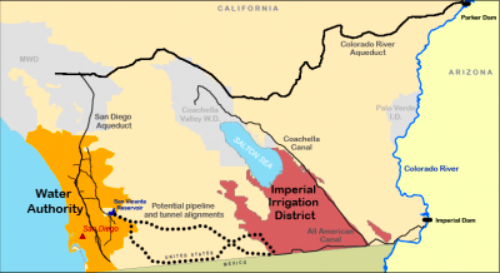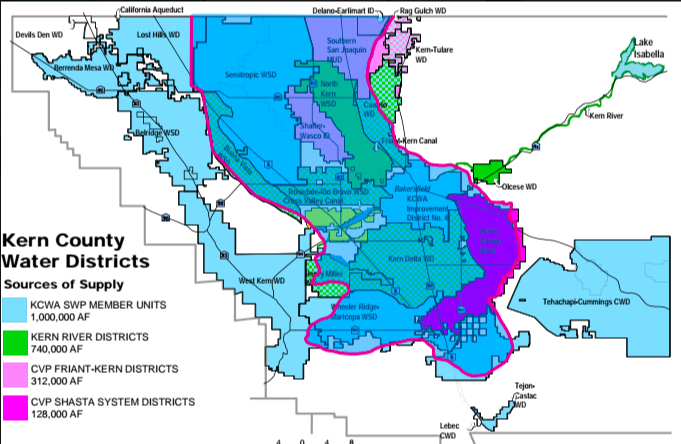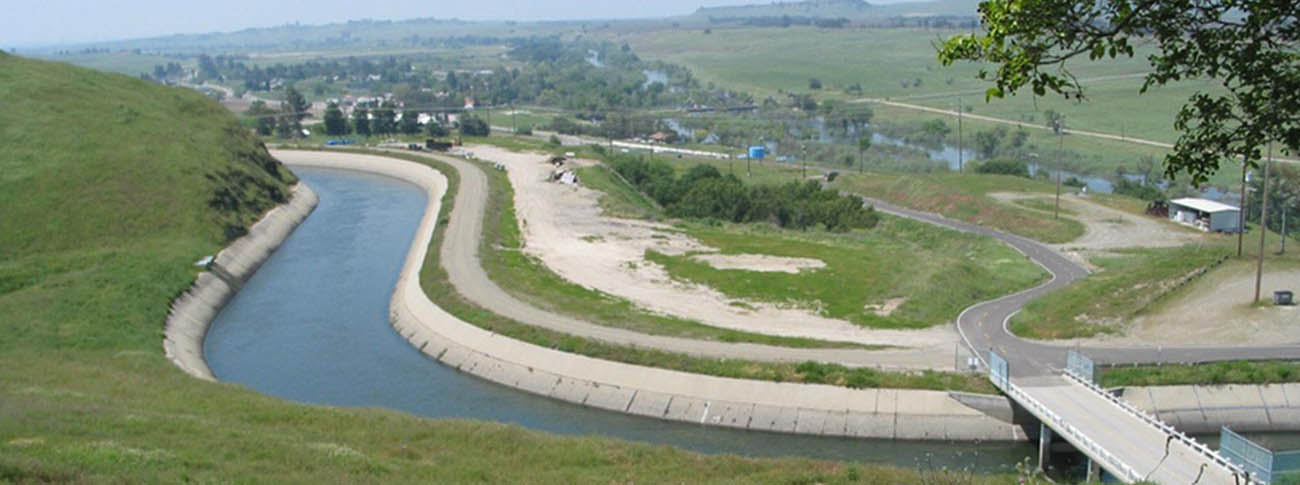
The Water Authority's independent Colorado River water supplies are delivered through the Colorado River Aqueduct. (Photo: sdcwa.org/)
Gov. Newsom’s Water Portfolio Has No Water Entrepreneurs
Governor’s water portfolio is not a plan and is in the form of an Executive Order
By Wayne Lusvardi, August 3, 2020 9:56 am
On July 28 Gov. Gavin Newsom issued what he called a Water Resilience Portfolio. Prior governors have put out ambitious water plans, such as Jerry Brown’s Water Fix and Eco-Restore Plans.
However, Newsom’s water portfolio is not a plan and is in the form of an Executive Order (No. N-10-19), like the Coronavirus emergency orders, that focuses on “climate change” as justification for fast tracking construction of the proposed Sites Reservoir and a water tunnel under the Sacramento Delta. The Sites Reservoir is to be built by the state Department of Water Resources and financed by 30 water agencies to develop 470,000 to 640,000 acre-feet of new water for dry years. Perhaps, the use of executive orders signal that Newsom is going to autocratically govern every aspect of state government using similar emergency powers as his declared Coronavirus emergency.
An acre-foot of water is a football field of water one-foot high, capable of providing potable water to two urban households in a wet year or plausibly four households during drought.
However, the largest source of new water developed in California since the State Water Project was completed 50 years ago did not come from government but from the entrepreneurial actions of two Texas billionaires, the Bass Brothers, who bought up 42,000 acres of land and water rights for $60 million in Imperial County that eventually ended up being transferred to the San Diego County Water Authority. This is the same way that the Los Angeles bought land voluntarily from farmers in Owens Valley in the early 1900’s. Newsom’s dictatorial orders have no room for such innovative and risk-taking actions to bust the decades old logjam on water policy in California.
In the past 50 years the only water projects that substantially added new net water supplies in California have been the:
- Imperial Irrigation District transfer of water to San Diego County in 2003 brought about by the private actions of the billionaire Bass Brothers from Texas (280,000-acre feet of water);
- The building of the Las Vaqueros Reservoir in Contra Costa County that provides water mainly to the East Bay suburbs of the San Francisco Bay that came about because of a 1988 voter approved ballot initiative, not the sole actions of government (160,000-acre-feet of water); and.
- The Carlsbad Oceanwater Desalination Plant in North San Diego County initiated by the San Diego County Water District in 2012 (56,000 acre-feet of water).
As shown in the table below, 56 percent of the new net water supplies in California in the last 50 years comes from entrepreneurial actions and 100% from regional water districts, not from state or federal government.
New Net Water Supplies After State Water Project (SWP)
|
Water Project |
Acre Feet of Water Capacity |
Year Built/Transacted |
Governor/ Water Agency/ Entrepreneur |
|
New State System Water Supplies After 1968 |
|||
|
Imperial Irrigation District to San Diego County Water Authority Water Transfer |
280,000 (56%) |
2003 |
Bass Brothers/ Arnold Schwarzenegger (R) Imperial County Irrigation Dist.-MWDSC |
|
Los Vaqueros Dam |
160,000 (32%) |
1988 voter approved 1998 built/ |
George Deukmejian (R) |
|
San Diego County Carlsbad Desalination Facility |
56,000 |
2012 |
SDCWA |
|
Offsetting Water Gain/Loss |
|||
|
Water Recycling MWD Agencies |
400,000 |
2000-2020 |
MWDSC agencies |
|
MWD Depleted Groundwater Supplies |
(400,000) |
2000-2020 |
MWDSC agencies |
|
Failed Reservoir Projects |
|||
|
Auburn Dam |
2,500,000 |
1972-1980 |
U.S. Congress |
|
Pending Reservoir Projects |
|||
|
Sites Reservoir |
470,000 – 640,000 |
2030 |
State Dept. Water Resources |
The Las Vaqueros Reservoir is in the process of raising the height of its dam 55-feet to 275,000 acre-feet of water, a 115,000 acre-feet increase in water supplies. The planned expansion of the reservoir was pursued in 2010 but failed because the Contra Costa Water District could not find other water agencies to invest in the project, excluding any entrepreneurial investors in a joint venture.
Other reservoirs have been built in California in the last 50 years, but they are pure storage down-stream reservoirs, not up-stream water basin reservoirs that capture new water supplies. For example, the giant 800,000 acre-foot capacity Diamond Valley Lake in Riverside County in Southern California is merely a repository for imported water from northern California and the Colorado River.
Following floods in Northern California, in 1965 the U.S. Congress approved the proposed Auburn Dam. The reservoir would have stored 2.5 million acre-feet of water. In 1972, however, environmental groups successfully sued to halt the project and construction halted in 1980. An attempt was made to restart the project in 2013 but went nowhere.
As shown in the above table, water recycling in Southern California generated 400,000 acre-feet of re-usable “new” water recycled from imported water. However, this was entirely offset by about 400,000 acre-feet in water lost due to depletion of groundwater supplies over the last 20 years. Water recycling is a zero-sum game.
Newsom’s novel Water Resilience Portfolio has been criticized by Restore-the-Delta and the Sierra Club as a “ruse” for fast-tracking the Sites Reservoir and the Delta Tunnel.
The Newsom Water Resilience Portfolio has seven investment principles, none of which includes the actions of water entrepreneurs, such as farmer John Vidovich who has been trying to put together a voluntary speculative groundwater market in Kern County for dry years.
Newsom’s proposed fast tracking of the Sites Reservoir is a long overdue government sponsored reservoir project. Unfortunately, Newsom’s portfolio does not include or encourage private investments in other new water development projects that have been so crucial in the past.
- Peter Gleick’s National Water Plan for California - October 12, 2020
- Court Opens Up Big Prop.13 Loophole for ‘Public Franchise Fees’ - October 2, 2020
- New Cal Grid CEO is Ex-Enron Green Power Trader - September 29, 2020




